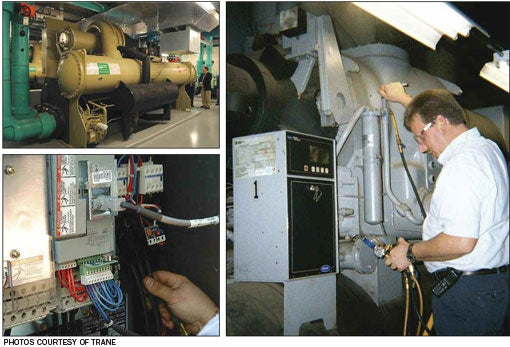Value added
 Group purchasing organizations (GPOs), which use aggregated purchasing volume to negotiate discounts with manufacturers, distributors and many other vendors, have become a standard channel for doing business in many parts of the health care industry. Until recently, however, they have not played a significant role in meeting the needs of health facilities professionals.
Group purchasing organizations (GPOs), which use aggregated purchasing volume to negotiate discounts with manufacturers, distributors and many other vendors, have become a standard channel for doing business in many parts of the health care industry. Until recently, however, they have not played a significant role in meeting the needs of health facilities professionals.
That has changed now that the scope of GPOs' purchasing has expanded beyond traditional bandages and gauze to include systems and services needed for facilities operations. Today, many GPOs meet a full spectrum of facilities management needs ranging from mechanical systems and services for large construction projects to maintenance, project management and energy management services.
Health facilities professionals can now gain significant value by utilizing GPOs, including cost savings and better use of time through a shortened bid process. While savings vary, one GPO estimates that its members recently saved $750,000 in HVAC expenses over a 12-month period.
How do GPOs operate?
Nearly every U.S. hospital (96 to 98 percent) uses GPO contracts for their purchasing functions, according to the Health Industry Group Purchasing Association (HIGPA). In fact, HIGPA reports that hospitals make an average of 72 percent of purchases using GPO contracts. From a cost standpoint, HIGPA says that GPOs save U.S. hospitals between 10 and 15 percent on overall purchasing, up to $33 billion each year.
GPOs are designed to provide products and services at lower costs, systemwide aggregation, quality control and decreased supply chain management. As a result, using GPO contracts saves money and time.
To understand how GPOs work, it is important to know that GPOs, in part, rely on fees paid by vendors for financing the services that the GPOs offer to health care providers. Typically, these administrative fees are based on the purchase price and purchasing method that the health care provider pays for a product purchased through a GPO contract.
The administrative fees are paid to the GPO when a member makes purchases from a contracted supplier under a specific group purchasing contract. According to HIGPA, GPOs benefit by earning administrative fees because this approach allows hospitals and health care providers to dedicate more resources to the direct provision of patient care.
Some vendors pay greater administrative fees to GPOs for direct purchases and installation. Vendors also provide service and maintenance agreements at competitive pricing and pay administrative fees on those agreements. This increases the potential share-back dividends that a facility may receive from the GPO with the added benefit of protecting existing budgets.
Setting the vision
From the beginning of the relationship with a GPO, health facilities professionals should make sure that they can always articulate the administration's objectives and how the GPO contracts fit into the hospital's overall mission and objectives. In meetings with C-suite executives, they should be prepared to provide regular verbal and written updates on utilization of the GPO contracts within their purview.
 |
| Among the products and services GPOs can cover are large centrifugal chillers for chilled water systems (upper left); and the maintenance required for mechanical systems, such as checking refrigerant pressure levels (right) and service on control panels (lower left). |
To gain the full benefit of working with a GPO, facilities professionals should track and maintain utilization and savings logs (e.g., resources, dollars and time) on an ongoing basis. Health facilities professionals also can leverage their understanding of GPOs to request funding and to promote themselves as team players who reach overall objectives for their departments and their facilities.
When it comes to planning purchases, facilities professionals should evaluate their needs for the next one to three years. Purchasing larger quantities of items that can be stored safely and economically can save on both the price per unit and on the overhead needed to make repeated purchases. Some prices may only be offered on a periodic basis. Timing of an entire project may need to shift if different dates will yield lower costs. Health facilities professionals should also allow time for systems that are custom-built.
Identify and evaluate
If health facilities professionals have not yet worked with their GPOs, they should begin by contacting their materials or procurement group for a list of GPO-contracted suppliers. Because most hospitals work with multiple GPOs, they should confirm whether purchases are run through a particular GPO.
This can be especially important if the health facility is trying to increase volume with a particular GPO to gain a better share-back dividend or reduce overall costs. Additionally, because most suppliers will only report and pay under one GPO, the facility may control which purchases run through which GPO.
If facilities professionals want more information about a particular supplier and their capabilities, they can reach out to the supplier's national account manager. This person can relate the supplier's experience and areas of expertise, explain what is covered locally under the contract and provide references for recently completed jobs.
Investigate the offerings
Investigating everything a GPO has to offer will often uncover additional savings opportunities. Before considering any purchase, health facilities professionals should consult their facility's contracts along with the terms, suppliers, pricing methods, systems and services.
They should determine if pricing is set and whether pricing discounts require a specific purchase volume in particular categories. They should also identify whether pricing runs annually or for the length of the contract, which is typically three years.
Health facilities professionals can sometimes coordinate with others in their health care system to obtain better pricing by aggregating their spending in a particular category. A hospital's materials manager can walk facilities professionals through more questions to identify the best options. Facilities professionals should also make sure they find out early in the process who will complete the required paperwork and who will sign off on it. Often, the materials procurement contact in an organization will handle this, though it sometimes takes place at the C-suite administration level.
Facilities professionals may be able to avoid the bid phase of many projects when using a GPO by demonstrating that the bid process the GPO used was sufficiently stringent. If facilities professionals have a preferred supplier with whom they want to work, they can ask their GPO to demonstrate the rigor and due diligence they took during the initial request for proposal (RFP) process.
For instance, a hospital facilities director in an East Coast rural hospital worked closely with the local GPO to better understand their contract, how to maximize savings and how to buy directly from a preferred vendor without going through the bid process. The GPO provided documentation detailing the RFP process they used to select the contracted vendors. Based on the rigorous RFP process, the facilities director was able to bypass the bid process, saving money and many hours of work.
If health facilities professionals are allowed to bypass the bid process, they should keep in mind that there may be dollar caps on purchases instituted by the GPO, the health care system or state and county laws, especially if the facility is publicly owned.
Some health care systems go beyond eliminating the bid process to standardize on fixed pricing with one supplier. This can allow them to obtain better pricing and terms, earn higher administrative fees and hasten procurement speed.
For instance, one major Midwestern health care system with 22 hospitals working through their GPO standardized on an industry-leading manufacturer with fixed pricing to dramatically shorten procurement time. Previously, new systems procurement involved a lengthy process of identifying the systems needed, competitively bidding them out and finally receiving the systems. By standardizing on one firm with preset pricing, the GPO was able to quickly select from available systems and cost-effectively obtain what was needed in less time.
As a result, whether undertaking a chiller change-out or a major hospital construction project, health care system members immediately know the preferred vendor. The health care system estimates it is able to save an additional 20 percent by using the GPO for standardized procurement of capital equipment. Health facilities managers can go from concept to deliverable in a much tighter time frame.
In another instance, a major health care system on the West Coast made the decision to standardize on one contracted supplier within their GPO. It not only saved an additional 10 to 15 percent, but it also significantly reduced procurement time.
 |
| Facilities professionals should confirm that installation and pricing by a third party will be covered under the GPO. |
Exploring financing options
Suppliers may provide additional financing options beyond those offered through the GPO. If a health facility pays a percentage up front to some suppliers, it may gain additional savings. Suppliers also may build a case with a lender to help customers obtain financing for a project.
Health facilities professionals should carefully evaluate the terms of service agreements. They should learn whether administrative fees will be paid on the agreement and, if so, how they are to be paid. For example, if a health facility signs a three-year maintenance agreement, the supplier may report and pay administrative fees to the GPO based on installment payments on the agreement, or they may report and pay the administrative fees at one time for the overall term of the contract.
Facilities professionals should also be sure they understand how service agreements work and how they are reported back to the GPO. They should determine whether there is special pricing for maintenance agreements and whether that applies to new and/or renewed agreements. They should also clarify whether there are different levels of maintenance to be considered and find out whether the agreements run for the term of the GPO contract or not.
Moreover, health facilities professionals should confirm that pricing and installation by a third party will be covered. If they go through a mechanical contractor, for example, they will need to check whether administrative fees will still be reported and paid back to the GPO. If facilities managers want to be certain that they use only contracted suppliers so they get credit through their GPOs, they should be sure to communicate that to the contractor or the third party early in the process.
Finally, health facilities professionals should check whether rentals are covered by their GPOs, especially in the summer months when an additional generator may be needed. When a natural disaster strikes, suppliers often step in to help members. If this is an important consideration, facilities professionals should ask whether the supplier they are considering will provide special pricing or pay administrative fees on rentals.
When considering a purchase, health facilities professionals should evaluate what the purchase means to their facilities in the short and long term. Does the supplier have the service people to provide required maintenance, or will it have to be fixed elsewhere? They may also need to check the supplier's ability to service other manufacturers' equipment.
Accruing benefits
When health facilities professionals invest the time and energy required to understand their GPO's capabilities, they will accrue additional benefits that are often left on the table.
These can include improving the health care facility's fiscal performance; tightening the delivery timeline for services; obtaining the best systems and services at the lowest prices; and achieving systemwide aggregation, improved quality control and decreased supply chain management.
They also will position themselves as key players within their health care organizations, paving the way for future professional and personal success.
Laura Rygielski-Preston, FACHE, is director of the health care market at Trane, and Kate Wickham is leader of GPOs for the health care market at Trane. They can be reached at LRygielski@trane.com and Kate.Wickham@trane.com.
| Sidebar - Building a relationship with a facility's GPO |
| Because health facilities professionals will be working with their group purchasing organization (GPO) representatives and targeted suppliers for a considerable period, they should take the time to foster strong relationships. In most cases, the sooner facilities professionals start working with their GPOs, the better will be their potential outcomes. Rather than wait until the project has been specified and bid, health facilities professionals should find out ahead of time whether a supplier can provide useful expertise for the design process and other phases of the project. The suppliers may also provide engineering experts or project management support, often at no cost or rolled into the contract cost. Because use of GPOs during the construction and renovation phases has increased, health facilities professionals can now take advantage of GPO resources to assist in the entire process: concept, design, bidding, construction/installation and long-term service. In fact, some GPOs will assign a full-time, on-site member of their staff during new construction to monitor delivery, installation and other key phases. Some smaller hospitals have even relied on their GPOs as mediators when issues arise with suppliers. For instance, when a piece of medical equipment malfunctioned at a small, rural West Coast hospital that is part of a large system, the facilities director and the vendor were unable to resolve the problems. Because the faulty equipment was purchased via the health care system's GPO, the facilities director reached out to the local GPO representative to help resolve the issues. Serving as an advocate for the hospital and as a mediator between the hospital and the vendor, the GPO representative helped resolve the problem. Thus, the facilities director benefited from his health care system's GPO relationship. The issues were successfully resolved, the facility's relationship with the vendor and the GPO continued, and the health facility director gained greater value from the health care system's GPO contract. Health facilities professionals also can obtain help with the funding process through their GPOs. For example, if they are unsure whether they will be able to obtain capital for an imminent project, the GPO and supplier can help obtain budget numbers and build a business case for the improvements. Suppliers can often provide estimates of the anticipated savings that the new systems will generate. Facilities professionals also can ask for comparisons of high-efficiency systems versus non-high-efficiency systems and for initial costs as well as one- and five-year returns on investment. Suppliers also can assist with other aspects of a project such as timeline, paperwork processing and even delivery options. For example, one health care facility contacted a supplier because the city was using the street on a day when a crane was scheduled to lift a large rooftop mechanical unit into place. The supplier worked with its factory to find a better delivery date for the health care facility. |




